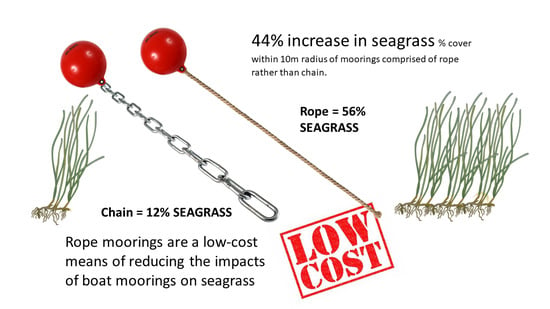Effectiveness of Moorings Constructed from Rope in Reducing Impacts to Seagrass
Abstract
:1. Introduction
2. Materials and Methods
Data Analysis
3. Results
3.1. Seagrass Cover
3.2. Seagrass Canopy Height
3.3. Rope versus Chain
4. Discussion
Author Contributions
Funding
Institutional Review Board Statement
Informed Consent Statement
Data Availability Statement
Acknowledgments
Conflicts of Interest
References
- Hastings, K.; Hesp, P.; Kendrick, G.A. Seagrass loss associated with boat moorings at Rottnest Island, Western Australia. Ocean Coast. Manag. 1995, 26, 225–246. [Google Scholar] [CrossRef]
- Macreadie, P.I.; Trevathan-Tackett, S.M.; Skilbeck, C.G.; Sanderman, J.; Curlevski, N.; Jacobsen, G.; Seymour, J.R. Losses and recovery of organic carbon from a seagrass ecosystem following disturbance. Proc. R. Soc. B 2015, 282, 20151537. [Google Scholar] [CrossRef] [PubMed]
- Martínez Vázquez, R.M.; Milán García, J.; De Pablo Valenciano, J. Analysis and Trends of Global Research on Nautical, Maritime and Marine Tourism. J. Mar. Sci. 2021, 9, 93. [Google Scholar] [CrossRef]
- Egerton, J. Management of the Seagrass Bed at Porth Dinllaen. Initial Investigation into the Use of Alternative Mooring Systems; Report for Gwynedd Council; Gwynedd Council: Caernarfon, UK, 2011. [Google Scholar]
- Unsworth, R.K.F.; Williams, B.; Jones, B.L.; Cullen-Unsworth, L.C. Rocking the Boat: Damage to Eelgrass by Swinging Boat Moorings. Front. Plant Sci. 2017, 8, 1309. [Google Scholar] [CrossRef] [PubMed]
- Dunic, J.C.; Brown, C.J.; Connolly, R.M.; Turschwell, M.P.; Côté, I.M. Long-term declines and recovery of meadow area across the world’s seagrass bioregions. Glob. Chang. Biol. 2021, 27, 4096–4109. [Google Scholar] [CrossRef] [PubMed]
- Turschwell, M.P.; Connolly, R.M.; Dunic, J.C.; Sievers, M.; Buelow, C.A.; Pearson, R.M.; Tulloch, V.J.D.; Côté, I.M.; Unsworth, R.K.F.; Collier, C.J.; et al. Anthropogenic pressures and life history predict trajectories of seagrass meadow extent at a global scale. Proc. Natl. Acad. Sci. USA 2021, 118, e2110802118. [Google Scholar] [CrossRef] [PubMed]
- Nordlund, L.M.; Koch, E.W.; Barbier, E.B.; Creed, J.C. Seagrass ecosystem services and their variability across genera and geographical regions. PLoS ONE 2016, 11, e0163091. [Google Scholar] [CrossRef] [PubMed]
- Parry-Wilson, H.M.; Rees, S.E.; Leather, H.; Cole, R.; Rugg, C.; Attrill, M.J. Assessing behavioural and social responses to an eco-mooring trial for Zostera marina conservation management in Torbay, Southwest England. Ocean Coast. Manag. 2019, 180, 104906. [Google Scholar] [CrossRef]
- Luff, A.L.; Sheehan, E.V.; Parry, M.; Higgs, N.D. A simple mooring modification reduces impacts on seagrass meadows. Sci. Rep. 2019, 9, 20062. [Google Scholar] [CrossRef] [PubMed]
- Glasby, T.M.; West, G. Dragging the chain: Quantifying continued losses of seagrasses from boat moorings. Aquat. Conserv. Mar. Freshw. Ecosyst. 2018, 28, 383–394. [Google Scholar] [CrossRef]
- Weller, S.D.; Johanning, L.; Davies, P.; Banfield, S.J. Synthetic mooring ropes for marine renewable energy applications. Renew. Energy 2015, 83, 1268–1278. [Google Scholar] [CrossRef]
- Rheinheimer, D.C.; Penfield, D.A. The Effects of type I error rate and power of the ANCOVA F test and selected alternatives under nonnormality and variance heterogeneity. J. Exp. Educ. 2001, 69, 373–391. [Google Scholar] [CrossRef]
- Underwood, A.J. Experiments in Ecology: Their Logical Design and Interpretation Using Analysis of Variance; Cambridge University Press: Cambridge, UK, 1997. [Google Scholar]
- McCloskey, R.M.; Unsworth, R.K.F. Decreasing seagrass density negatively influences associated fauna. PeerJ 2015, 3, e1053. [Google Scholar] [CrossRef] [PubMed]
- Collins, K.J.; Suonpää, A.M.; Mallinson, J.J. The impacts of anchoring and mooring in seagrass, Studland Bay, Dorset, UK. Underw. Technol. Int. J. Soc. Underw. 2010, 29, 117–123. [Google Scholar] [CrossRef]
- Glasby, T.M.; West, G. Estimating Losses of Posidonia Australis due to Boat Moorings in Lake Macquarie, Port Stephens and Wallis Lake; NSW Department of Primary Industries: Orange, Australia, 2015. [Google Scholar]
- Walker, D.I.; Lukatelich, R.J.; Bastyan, G.; McComb, A.J. Effect of boat moorings on seagrass beds near perth, Western-Australia. Aquat. Bot. 1989, 36, 69–77. [Google Scholar] [CrossRef]
- Rao, S.N.; Prasad, Y.V.S.N. Estimation of Uplift Capacity of Helical Anchors in Clays. J. Geotech. Eng. 1993, 119, 352–357. [Google Scholar] [CrossRef]




Publisher’s Note: MDPI stays neutral with regard to jurisdictional claims in published maps and institutional affiliations. |
© 2022 by the authors. Licensee MDPI, Basel, Switzerland. This article is an open access article distributed under the terms and conditions of the Creative Commons Attribution (CC BY) license (https://creativecommons.org/licenses/by/4.0/).
Share and Cite
Unsworth, R.K.F.; Cullen-Unsworth, L.C.; Hope, J.N.; Jones, B.L.H.; Lilley, R.J.; Nuuttila, H.K.; Williams, B.; Esteban, N.E. Effectiveness of Moorings Constructed from Rope in Reducing Impacts to Seagrass. Oceans 2022, 3, 431-438. https://doi.org/10.3390/oceans3030029
Unsworth RKF, Cullen-Unsworth LC, Hope JN, Jones BLH, Lilley RJ, Nuuttila HK, Williams B, Esteban NE. Effectiveness of Moorings Constructed from Rope in Reducing Impacts to Seagrass. Oceans. 2022; 3(3):431-438. https://doi.org/10.3390/oceans3030029
Chicago/Turabian StyleUnsworth, Richard K. F., Leanne C. Cullen-Unsworth, James N. Hope, Benjamin L. H. Jones, Richard J. Lilley, Hanna K. Nuuttila, Beth Williams, and Nicole E. Esteban. 2022. "Effectiveness of Moorings Constructed from Rope in Reducing Impacts to Seagrass" Oceans 3, no. 3: 431-438. https://doi.org/10.3390/oceans3030029








